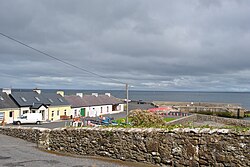Kilcummin
Kilcummin
Cill Chuimín | |
|---|---|
Townland | |
 Kilcummin pier | |
 Kilcummin Location in Ireland | |
| Coordinates: 54°16′44″N 9°12′50″W / 54.278888°N 9.213946°WCoordinates: 54°16′44″N 9°12′50″W / 54.278888°N 9.213946°W | |
| Country | Ireland |
| Province | Connacht |
| County | County Mayo |
| Time zone | UTC+0 (WET) |
| • Summer (DST) | UTC-1 (IST (WEST)) |
| Irish Grid Reference | G206379 |
Kilcummin (Irish: Cill Chuimín)[1] is a beachhead and civil parish on the northern coast of County Mayo in Ireland.[2] Traditionally a fishing community,[3] the Kilcummin area is sparsely populated. The "Tír Sáile - North Mayo Sculpture Trail" and "Tour d'Humbert" tourist route lead through the area. Kilcummin overlooks Killala Bay, the blue flag beach "An Trá nRoss", "Bartra Island" and lies on the opposite shore to Enniscrone and its beach in County Sligo.
Name[]
Kilcummin is named after the early Irish saint Cuimín, and derives from the Irish Cill Chuimín, meaning "church of Cuimín".[1] Other variants of the Irish spelling (seen on local signage) include "Cilcummin" and "Cill Chummín".
Prior to being named Kilcummin a map of Connaught from the 5th Century indicates that the area was originally known as "Forrac".[4]
History[]
Local history has it that Saint Patrick, the patron saint of Ireland, came through Kilcummin on his travels from Ulster to Croagh Patrick.[citation needed] In Killala, about 10 miles away from Kilcummin, he is said to have founded a church, on which grounds the modern-day Church of Ireland cathedral has been built. The remains of the church of Saint Cuimín (for which the area is named) are still to be found in the local cemetery, along with a holy well at which to this day worshippers come to pray.[3] Saint Cuimín's grave has been lost over the centuries, but it is believed that a group of stones in Kilcummin cemetery once belonged to his tomb.[5][6]
Kilcummin is noted as the site where a French expedition commanded by General Humbert[7] landed on 22 August 1798, in an attempt to assist Irish rebels during the 1798 rebellion. Humbert commanded three frigates, the Concorde, Franchise, and the Médée altogether carrying 1070 French forces, three cannon, and approximately 3000 muskets.[8]
Gallery[]

Signpost on the Lacken Road showing variant Irish spelling

Kilcummin cemetery

Headstone on the grave of St Cummin, with the old church of St Cummin (dated to pre-8th Century)

Leac A’ Chaonaigh - the site of the French Landing in 1798 near Kilcummin village.
References[]
| Wikimedia Commons has media related to Kilcummin. |
- ^ Jump up to: a b "Cill Chuimín / Kilcummin". logainm.ie. Placenames Database of Ireland. 4 August 2019.
- ^ "Civil Parish of Kilcummin, Co. Mayo". townlands.ie. Irish Townlands. Retrieved 4 August 2019.
- ^ Jump up to: a b "Kilcummin (Cill Chuimín - Cuimíns Church)". sacredlandscapes.ie. Retrieved 4 August 2019.
- ^ H.T. Knox (1908). The History of the County of Mayo. Dublin: Hodges, Figgis & Co.
- ^ "Kilcummin Graveyard Headstones". GoldenLangan.com. Retrieved 4 August 2019.
- ^ "Early Christian Sites - Kilcummin". earlychristianireland.org.[dead link]
- ^ Bill Peterson (2001). "In the Footsteps of Général Humbert: The French Invasion of Ireland, 1798". wargame.ch. Archived from the original on 31 January 2008.
- ^ Diary of an Expedition, Humbert's Army of Ireland, archived from the original on 12 June 2016, retrieved 4 August 2019 – via iol.ie
- Towns and villages in County Mayo





